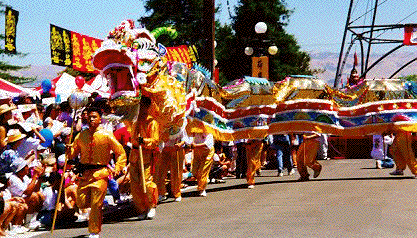San Jose’s Golden Dragon
Awakening from a 7-Decade Sleep

Thanks to funding from the San Jose Redevelopment Agency and Chinese Historical and Cultural Project, San Jose’s Golden Dragon, glistening with thousands of sequins and spangles, awakened on July 30, 1995, after 71 years of slumber.
According to educational tape at the Chinese Cultural Center in Sunnyvale, CA, the earliest documentation of the dragon dance was in the Western Han Dynasty about 200 BC. The dance was done to beg for rain during a pernicious drought, by groups of males from children to elderly after a three-day purifying fast.
It is likely that as soon as the early Chinese in America had a large enough audience and means to do so, dragon and lion dances were practiced to bring good blessings and uplift the spirit, probably in the early 1900s. In California, Marysville had a dragon in its Bok-Kai Festival Parades dating to the 1930s. A dragon is featured in the San Francisco Chinese New Year Parade, which started some 55 years ago. San Jose was known for its Da-Jui Festival to appease the spirits who had no descendants to tend to them.
The San Jose Dragon’s last documented appearance was in front of the Ng Shing Gung in San Jose’s Heinlenville Chinatown in 1924. Then Gung Lum, the Golden Dragon, disappeared from public view. Decades later, with the aid of Redevelopment and CHCP funding, a donated head and tail from a dilapidated San Francisco dragon were restored and a new body created. The new Golden Dragon awakened at the 1995 Chinese Summer Festival, when a mixture of potent herbs was rubbed onto his eyes in the traditional “eye-dotting” ceremony.
Due to the size of the dragon, the dragon dance requires disciplined practice with a large dedicated group of dancers. Traditionally, these dancers have been martial artists with trained vigor. Recently, in order to preserve this disappearing art, many variations have been devised to encourage the participation of youth and women.
The San Jose Dragon has made 152 appearances since 1995. In 1999, CHCP contributed $5,000 for the purchase of a new dragon head and other maintenance and community performance expenses.
In the video below, you can enjoy the Golden Dragon glittering in the sun as he chases the Pearl at the Chinese Summer Festival, and you can hear the drums and cymbals sound too:
Upcoming Events
The Chinese Historical and Cultural Project | info@chcp.org | © Copyright 1996-2026. All rights reserved.

